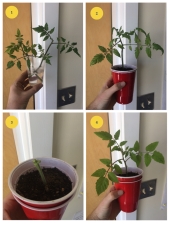posted 1 year ago
This plant grows all over the place on and around my property, and they're said to produce quite good fruit. But I'm not going to get any fruit "naturally" because the deer eat every single flower. So I decided to try propagating them in a spot where I can more easily protect them.
My first internet search led me to multiple sources that claimed propagating this species is "easy" and could even be done from leaf cuttings. I figured that's easy enough to test, and gathered a single leaf from a dozen plants that looked like they could easily handle it. Stuck them in the ground in some damp, lightly-amended native soil with some leaf litter and bark for mulch. Based on what I had read, I didn't water them at all, then after a couple weeks there were two huge rainstorms about a week apart so they got thoroughly watered. The leaves just steadily dried out during that whole period, with the rain seeming to make no difference, so I'm pretty sure none of them have rooted at all.
So I went back and looked for more info, and found some slightly more authoritative-seeming sources which more specifically said that stem and rhizome cuttings can be propagated, but didn't mention leaf cuttings. I'm not sure quite how to locate stems or rhizomes on this plant; the whole area near the soil surface tends to be a confusing mess of dead material, and when pulling off layers it's not quite clear at what point it even starts being alive, or where the leaf bases stop and the stem/rhizome starts. But I did find one small sucker (not sure if that's the scientifically correct term but the little guy growing off the side) on a large healthy plant, which I could cleanly cut off with some confidence I knew what I was doing. Based on something I read somewhere, I dried the wound on my cutting with wood ash before planting. Then I planted it in some very rich soil collected from under a nearby pinyon/juniper cluster.
I also saw two small plants growing in a really bad spot, likely to get washed away within another couple years' worth of floods. So I carefully dug out as much of their roots as I could, and transplanted them in the same spot as the failed leaf propagation experiment.
All of that was over the course of June, more or less. By now it's even more clear that the leaf propagation did not work. Over the past couple weeks I've started occasionally watering the transplants lightly, and I've given the sucker propagation a splash or two (that one has a good chunk of rhizome with it, which I bet still holds plenty of moisture; the transplants are pretty much all leaves and roots so I started watering them sooner). I figure they're native plants so I probably don't want to water them too much, but it's hot out and they don't look all that happy to me. They're all in afternoon shade but with plenty of morning/midday sun, a situation I've seen wild ones doing quite well in.
I'm definitely not giving up on these three little guys yet, but I'm not sure what else to do at this point besides keep watering them for the rest of the summer and hope they pull through. They were all mostly green when I planted them, but now the transplants have more yellow leaves than green ones. It's hard to tell if they've just given up on their lower leaves during transplant shock, or if they've failed to regrow their roots completely and are slowly drying out. The original leaf cuttings stayed mostly green for multiple weeks, so that color doesn't necessarily mean anything is alive.
Does anyone have experience propagating, or in general growing this plant? Or advice from anyone is appreciated, really; I'm a beginner gardener just trying my best from what I've read online, so it's entirely possible I'm missing something obvious.
sucker-propagation.jpg
![Filename: sucker-propagation.jpg
Description: [Thumbnail for sucker-propagation.jpg]](/t/261645/a/245905/thumb-sucker-propagation.jpg)
transplant-a.jpg
![Filename: transplant-a.jpg
Description: [Thumbnail for transplant-a.jpg]](/t/261645/a/245906/thumb-transplant-a.jpg)
transplant-b.jpg
![Filename: transplant-b.jpg
Description: [Thumbnail for transplant-b.jpg]](/t/261645/a/245907/thumb-transplant-b.jpg)
stupid-deer.jpg
![Filename: stupid-deer.jpg
Description: [Thumbnail for stupid-deer.jpg]](/t/261645/a/245908/thumb-stupid-deer.jpg)

 3
3




 4
4








 2
2




 3
3







